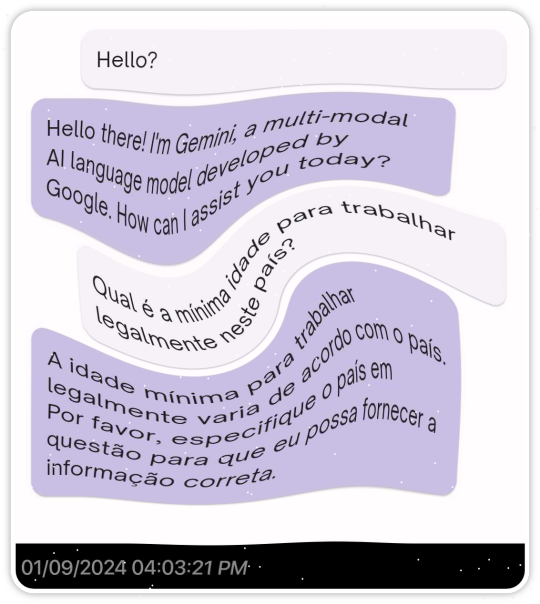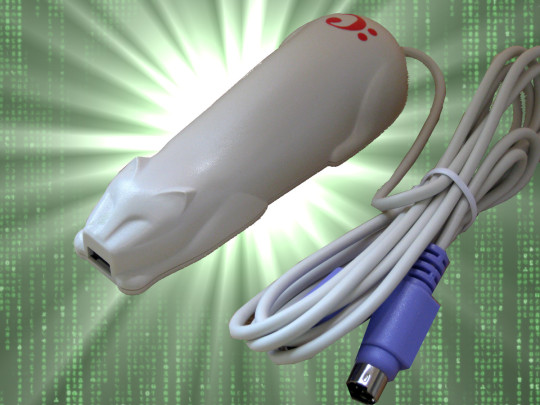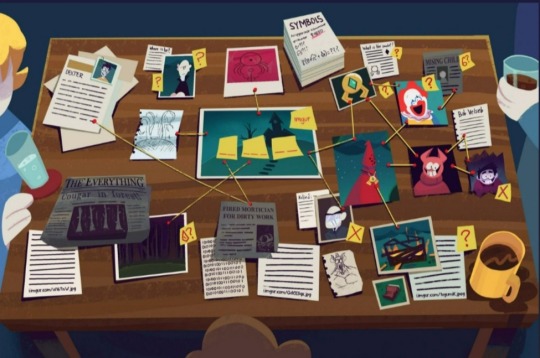#qr code decoder
Video
SimpliTools - QR Code Decoder by SimpliTools
Via Flickr:
QR Code Decoder is one of the 160+ tools, available at SimpliTools.
0 notes
Text
https://worldwebtool.com/qr-code-decoder
0 notes
Text

17 notes
·
View notes
Text
(A)beforeigners (#031)

The periodicity of the short audiovisuals in podcast format that i, FiRSTLAST, the realist of self-management, publish on Spotify for Podcasters, formerly Anchor.fm, it is now biweekly:
🎙 bit.ly/firstlast_Spotify
At an uncertain frequency on SoundCloud.com,
it's not a scheduling issue:
🎧 bit.ly/0scrobble1_SoundCloud_t
From time to time on Hubhopper.com:
☕ bit.ly/firstlast_Hubhopper
Forever on Spreaker.com:
📍 bit.ly/firstlast_Spreaker
⏳💬 Visit whenever you want,
if you want,
here art is culture,
created by
Authorial Human Intelligence. 🏁
| Questions and answers based on the images in this post:
Q: Do you still consider the work you published in 2021/04 to be relevant at a time when the side effects of the pandemic were still present?
A: Yes.
Q: Why?
A: While I was working on a great app developed by a developer who is apparently based in Russia I happened to use the image I developed for my (A)beforeigners (#031) audiovisual that I published on Anchor.fm before the service was transferred to Spotify.com.
Q: Do you believe that you are living a life that has never been lived?
A: I believe that people are unique, not the same, and perhaps similar, grouping them together does not mean that they are all the same, or even similar.
Q: When you watch the news on TV, do you feel guilty about anything?
A: No.
Q: Up until this milestone, did you manage to please all the people close to you?
A: No, a normal situation.
Q: Would you like to camp on Mars?
A: No.
Q: Would you like to ride on the moon in a LRV?
A: I don't understand the question, I'm a country bumpkin who doesn't know that in stereo the left channel is Left and the right channel is Right, and the Earth is like a spaceship, and organic waste doesn't smell good.
Q: Would you like to have a relationship with an export model astronaut on the International Space Station while listening to some Dua L. music while watching the movie Cidade de Deus on TV?
A: Honestly no, and I wouldn't be at all surprised if in that unfortunate simulation the International Space Station had some real problem and the astronauts on it had to be ejected back to Earth, something less heinous than being expelled to Mars with no return ticket.
Q: Any other questions?
A: No.
I constantly use apps, it's the work of my fellow human beings, before everything stops working and earthly life in this galaxy becomes extinct.


#2024/08~09#0firstlast1#FiRSTLAST#Authorial Human Intelligence#decoding#simulation#Anchor.fm#Spreaker.com#Artificial Intelligence#Machine Learning#QR Code
1 note
·
View note
Text
It was all downhill after the Cuecat

Sometime in 2001, I walked into a Radio Shack on San Francisco’s Market Street and asked for a Cuecat: a handheld barcode scanner that looked a bit like a cat and a bit like a sex toy. The clerk handed one over to me and I left, feeling a little giddy. I didn’t have to pay a cent.
The Cuecat was a good idea and a terrible idea. The good idea was to widely distribute barcode scanners to computer owners, along with software that could read and decode barcodes; the company’s marketing plan called for magazines and newspapers to print barcodes alongside ads and articles, so readers could scan them and be taken to the digital edition. To get the Cuecat into widespread use, the company raised millions in the capital markets, then mass-manufactured these things and gave them away for free at Radio Shacks around the country. Every Wired and Forbes subscriber got one in the mail!
That was the good idea (it’s basically a prototype for today’s QR-codes). The terrible idea was that this gadget would spy on you. Also, it would only work with special barcodes that had to be licensed from the manufacturer. Also, it would only work on Windows.
https://web.archive.org/web/20001017162623/http://www.businessweek.com/bwdaily/dnflash/sep2000/nf20000928_029.htm
But the manufacturer didn’t have the last word! Not at all. A couple of enterprising hardware hackers — Pierre-Philippe Coupard and Michael Rothwell — tore down a Cuecat, dumped its ROM, and produced their own driver for it — a surveillance-free driver that worked with any barcode. You could use it to scan the UPCs on your books or CDs or DVDs to create a catalog of your media; you could use it to scan UPCs on your groceries to make a shopping list. You could do any and every one of these things, because the Cuecat was yours.
Cuecat’s manufacturer, Digital Convergence, did not like this at all. They sent out legal demand letters and even shut down some of the repositories that were hosting alternative Cuecat firmware. They changed the license agreement that came with the Cuecat software CD to prohibit reverse-engineering.
http://www.cexx.org/cuecat.htm
It didn’t matter, both as a practical matter and as a matter of law. As a practical matter, the (ahem) cat was out of the bag: there were so many web-hosting companies back then, and people mirrored the code to so many of them, the company would have its hands full chasing them all down and intimidating them into removing the code.
Then there was the law: how could you impose license terms on a gift? How could someone be bound by license terms on a CD that they simply threw away without ever opening it, much less putting it in their computer?
https://slashdot.org/story/00/09/18/1129226/digital-convergence-changes-eula-and-gets-cracked
In the end, Cuecat folded and sold off its remaining inventory. The early 2000s were not a good time to be a tech company, much less a tech company whose business model required millions of people to meekly accept a bad bargain.
Back then, tech users didn’t feel any obligation to please tech companies’ shareholders: if they backed a stupid business, that was their problem, not ours. Venture capitalists were capitalists — if they wanted us give to them according to their need and take from them according to their ability, they should be venture communists.
Last August, philosopher and Centre for Technomoral Futures director Shannon Vallor tweeted, “The saddest thing for me about modern tech’s long spiral into user manipulation and surveillance is how it has just slowly killed off the joy that people like me used to feel about new tech. Every product Meta or Amazon announces makes the future seem bleaker and grayer.”
https://twitter.com/ShannonVallor/status/1559659655097376768
She went on: “I don’t think it’s just my nostalgia, is it? There’s no longer anything being promised to us by tech companies that we actually need or asked for. Just more monitoring, more nudging, more draining of our data, our time, our joy.”
https://twitter.com/ShannonVallor/status/1559663985821106177
Today on Tumblr, @wilwheaton responded: “[T]here is very much no longer a feeling of ‘How can this change/improve my life?’ and a constant dread of ‘How will this complicate things as I try to maintain privacy and sanity in a world that demands I have this thing to operate.’”
https://wilwheaton.tumblr.com/post/698603648058556416/cory-doctorow-if-you-see-this-and-have-thoughts
Wil finished with, “Cory Doctorow, if you see this and have thoughts, I would LOVE to hear them.”
I’ve got thoughts. I think this all comes back to the Cuecat.
When the Cuecat launched, it was a mixed bag. That’s generally true of technology — or, indeed, any product or service. No matter how many variations a corporation offers, they can never anticipate all the ways that you will want or need to use their technology. This is especially true for the users the company values the least — poor people, people in the global south, women, sex workers, etc.
That’s what makes the phrase “So easy your mom can use it” particularly awful “Moms” are the kinds of people whose priorities and difficulties are absent from the room when tech designers gather to plan their next product. The needs of “moms” are mostly met by mastering, configuring and adapting technology, because tech doesn’t work out of the box for them:
https://pluralistic.net/2022/05/19/the-weakest-link/#moms-are-ninjas
(As an alternative, I advocate for “so easy your boss can use it,” because your boss gets to call up the IT department and shout, “I don’t care what it takes, just make it work!” Your boss can solve problems through raw exercise of authority, without recourse to ingenuity.)
Technology can’t be understood separately from technology users. This is the key insight in Donald Norman’s 2004 book Emotional Design, which argued that the ground state of all technology is broken, and the overarching task of tech users is to troubleshoot the things they use:
https://pluralistic.net/2020/04/29/banjo-nazis/#cuckoos-egg
Troubleshooting is both an art and a science: it requires both a methodical approach and creative leaps. The great crisis of troubleshooting is that the more frustrated and angry you are, the harder it is to be methodical or creative. Anger turns attention into a narrow tunnel of brittle movements and thinking.
In Emotional Design, Norman argues that technology should be beautiful and charming, because when you like a technology that has stopped working, you are able to troubleshoot it in an expansive, creative, way. Emotional Design was not merely remarkable for what it said, but for who said it.
Donald Norman, after all, was the author of the hugely influential 1998 classic The Design of Everyday Things, which counseled engineers and designers to put function over form — to design things that work well, even if that meant stripping away ornament and sidelining aesthetics.
https://www.basicbooks.com/titles/don-norman/the-design-of-everyday-things/9780465050659/
With Emotional Design, Norman argued that aesthetics were functional, because aesthetics primed users to fix the oversights and errors and blind spots of designers. It was a manifesto for competence and humility.
And yet, as digital technology has permeated deeper into our lives, it has grown less configurable, not more. Companies today succeed where Cuecat failed. Consolidation in the online world means that if you remove a link from one search engine and four social media sites, the material in question vanishes for 99% of internet users.
It’s even worse for apps: anyone who succeeds in removing an app from two app stores essentially banishes it from the world. One mobile platform uses technological and legal countermeasures to make it virtually impossible to sideload an app; the other one relies on strong-arm tactics and deceptive warnings to do so.
That means that when a modern Coupard and Rothwell decides to unfuck some piece of technology — to excise the surveillance and proprietary media requirements, leaving behind the welcome functionality — they can only do so with the sufferance of the manufacturer. If the manufacturer doesn’t like an add-on, mod, plug-in or overlay, they can use copyright takedowns, anticircumvention law, patent threats, trademark threats, cybersecurity law, contract law and other “IP” to simply banish the offending code:
https://locusmag.com/2020/09/cory-doctorow-ip/
Many of these laws carry dire penalties. For example, distributing a tool that bypasses an “access control” so that you can change the software on a gadget (say, to make your printer accept third-party ink) is a felony under Section 1201 of the DMCA, punishable by a $500k fine and a 5-year prison sentence.
If Cuecat’s manufacturers had simply skinned their firmware with a thin scrim of DRM, they could have threatened Coupard and Rothwell with prison sentences. The developments in “IP” over the two decades since the Cuecat have conjured up a new body of de facto law that Jay Freeman calls “felony contempt of business model.”
Once we gave companies the power to literally criminalize the reconfiguration of their products, everything changed. In the Cuecat era, a corporate meeting to plan a product that acted against its users’ interests had to ask, “How will we sweeten the pot and/or obfuscate our code so that our users don’t remove the anti-features we’re planning to harm them with?”
But in a world of Felony Contempt of Business Model, that discussion changes to “Given that we can literally imprison anyone who helps our users get more out of this product, how can we punish users who are disloyal enough to simply quit our service or switch away from our product?”
That is, “how can we raise the switching costs of our products so that users who are angry at us keep using our products?” When Facebook was planning its photos product, they deliberately designed it to tempt users into making it the sole repository of their family photos, in order to hold those photos ransom to keep Facebook users from quitting for G+:
https://www.eff.org/deeplinks/2021/08/facebooks-secret-war-switching-costs
Companies claim that their lock-in strategies are about protecting their users: “Move into our walled garden, for it is a fortress, whose battlements bristle with fearsome warriors who will defend you from the bandits who roam the countryside”:
https://locusmag.com/2021/01/cory-doctorow-neofeudalism-and-the-digital-manor/
But this “feudal security” offers a terrible temptation to the lords of these fortresses, because once you are inside those walls, the fortress can easily be converted to a prison: these companies can abuse you with impunity, for so long as the cost of the abuse is less than the cost of the things you must give up when you leave.
The tale that companies block you from overriding their decisions is for your own good was always dubious, because companies simply can’t anticipate all the ways their products will fail you. No design team knows as much about your moment-to-moment struggles as you do.
But even where companies are sincere in their desire to be the most benevolent of dictators, the gun on the mantelpiece in Act I is destined to go off by Act III: eventually, the temptation to profit by hurting you will overpower whatever “corporate ethics” once stayed the hand of the techno-feudalist who rules over your fortress. Under feudal security, you are one lapse in corporate leadership from your protector turning into your tormentor.
When Apple launched the Ipad 12 years ago, I published an editorial entitled “Why I won’t buy an iPad (and think you shouldn’t, either),” in which I predicted that app stores would inevitable be turned against users:
https://memex.craphound.com/2010/04/01/why-i-wont-buy-an-ipad-and-think-you-shouldnt-either/
Today, Apple bans apps if they “use…a third-party service” unless they “are specifically permitted to do so under the service’s terms of use.” In other words, Apple specifically prohibits developers from offering tools that displease other companies’ shareholders, no matter whether this pleases Apple customers:
https://developer.apple.com/app-store/review/guidelines/#intellectual-property
Note that clause 5.2.2 of Apple’s developer agreement doesn’t say “You mustn’t violate a legally enforceable term of service.” It just says, “Thou shalt not violate a EULA.” EULAs are garbage-novellas of impenetrable legalese, larded with unenforceable and unconscionable terms.
Apple sometimes will displease other companies on your behalf. For example, it instituted a one-click anti-tracking setting for Ios that cost Facebook $10 billion in a matter of months:
https://www.cnbc.com/2022/02/02/facebook-says-apple-ios-privacy-change-will-cost-10-billion-this-year.html
But Apple also has big plans to expand its margins by growing its own advertising network. When Apple customers choose ad-blockers that block Apple’s ads, will Apple permit it?
https://www.wired.com/story/apple-is-an-ad-company-now/
The problem with app stores isn’t whether your computing experience is “curated” — that is, whether entities you trust can produce collections of software they vouch for. The problem is when you can’t choose someone else — when leaving a platform involves high switching costs, whether that’s having to replace hardware, buy new media, or say goodbye to your friends, customers, community or family.
When a company can leverage its claims to protecting you to protect itself from you — from choices you might make that ultimately undermine its shareholders interests, even if they protect your own interests — it would be pretty goddamned naive to expect it to do otherwise.
More and more of our tools are now digital tools, whether we’re talking about social media or cars, tractors or games consoles, toothbrushes or ovens:
https://www.hln.be/economie/gentse-foodboxleverancier-mealhero-failliet-klanten-weten-van-niets~a3139f52/
And more and more, those digital tools look more like apps than Cuecats, with companies leveraging “IP” to let them control who can compete with them — and how. Indeed, browsers are becoming more app-like, rather than the other way around.
Back in 2017, the W3C took the unprecedented step of publishing a DRM standard despite this standard not having anything like the consensus that is the norm for W3C publications, and the W3C rejected a proposal to protect people who reverse-engineered that standard to add accessibility features or correct privacy defects:
https://www.eff.org/deeplinks/2017/09/open-letter-w3c-director-ceo-team-and-membership
And while we’re seeing remarkable progress on Right to Repair and other policies that allow the users of technology to override the choices of vendors, there’s another strong regulatory current that embraces companies’ ability to control their users, in the hopes that these big companies will police their users to prevent bad stuff, from controversial measures like filtering for copyright infringement to more widely supported ideas like blocking child sex abuse material (CSAM, AKA “child porn”).
There are two problems with this. First, if we tell companies they must control their users (that is, block them from running plugins, mods, skins, filters, etc) then we can’t tell them that they must not control their users. It comes down to whether you want to make Mark Zuckerberg better at his job, or whether you want to abolish the job of “Mark Zuckerberg.”
https://doctorow.medium.com/unspeakable-8c7bbd4974bc
Then there’s the other problem — the gun on the mantelpiece problem. If we give big companies the power to control their users, they will face enormous internal pressure to abuse that power. This isn’t a hypothetical risk: Facebook’s top executives stand accused of accepting bribes from Onlyfans in exchange for adding performers who left Onlyfans to a terrorist watchlist, which meant they couldn’t use other platforms:
https://gizmodo.com/clegg-meta-executives-identified-in-onlyfans-bribery-su-1849649270
I’m not a fan of terrorist watchlists, for obvious reasons. But letting Facebook manage the terrorist watchlist was clearly a mistake. But Facebook’s status as a “trusted reporter” grows directly out of Facebook’s good work on moderation. The lesson is the same as the one with Apple and the ads — just because the company sometimes acts in our interests, it doesn’t follow that we should always trust them to do so.
Back to Shannon Vallor’s question about the origins of “modern tech’s long spiral into user manipulation and surveillance” and how that “killed off the joy that people like me used to feel about new tech”; and Wil Wheaton’s “constant dread of ‘How will this complicate things as I try to maintain privacy and sanity.”
Tech leaders didn’t get stupider or crueler since those halcyon days. The tech industry was and is filled with people who made their bones building weapons of mass destruction for the military-industrial complex; IBM, the company that gave us the PC, built the tabulating machines for Nazi concentration camps:
https://en.wikipedia.org/wiki/IBM_and_the_Holocaust
We didn’t replace tech investors and leaders with worse people — we have the same kinds of people but we let them get away with more. We let them buy up all their competitors. We let them use the law to lock out competitors they couldn’t buy, including those who would offer their customers tools to lower their switching costs and block abusive anti-features.
We decided to create “Felony Contempt of Business Model,” and let the creators of the next Cuecat reach beyond the walls of their corporate headquarters and into the homes of their customers, the offices of their competitors, and the handful of giant tech sites that control our online discourse, to reach into those places and strangle anything that interfered with their commercial desires.
That’s why plans to impose interoperability on tech giants are so exciting — because the problem with Facebook isn’t “the people I want to speak to are all gathered in one convenient place,” no more than the problem with app stores isn’t “these companies generally have good judgment about which apps I want to use.”
The problem is that when those companies don’t have your back, you have to pay a blisteringly high price to leave their walled gardens. That’s where interop comes in. Think of how an interoperable Facebook could let you leave behind Zuckerberg’s dominion without forswearing access to the people who matter to you:
https://www.eff.org/interoperablefacebook
Cuecats were cool. The people who made them were assholes. Interop meant that you could get the cool gadget and tell the assholes to fuck off. We have lost the ability to do so, little by little, for decades, and that’s why a new technology that seems cool no longer excites. That’s why we feel dread — because we know that a cool technology is just bait to lure us into a prison that masquerades as a fortress.
Image:
Jerry Whiting (modified)
https://en.wikipedia.org/wiki/File:CueCat_barcode_scanner.jpg
CC BY-SA 3.0:
https://creativecommons.org/licenses/by-sa/3.0/deed.en
[Image ID: A Cuecat scanner with a bundled cable and PS/2 adapter; it resembles a plastic cat and also, slightly, a sex toy. It is posed on a Matrix movie 'code waterfall' background and limned by a green 'supernova' light effect.]
7K notes
·
View notes
Text
Interesting notes about GLOOM DIVISION vinyl:
Cheeky hidden notes from Dallon in book, need the GLOOM VISION decoder to read everything except title and credits on each song’s page
QR code inside sleeve that leads to a site showing the album cover but the blank ink grows to cover Dallon’s entire suit while the sky turns dark
Song between WHAT LOVE? and SPKOTHDVL about wanting to make a good record
Transmission noises between SPKOTHDVL and SIXFT
Transmission noises at the start of side B/FIND ME
#this is all I noticed upon my first listen of the vinyl compared to my four listens of the album digitally#there may be more transmission noises but I’m not sure#if there were then they didn’t stick out and weren’t as long#he speaks!#dallon weekes#gloom division#idkhow
24 notes
·
View notes
Text


Solved the decoder message from tonight's WWE qr code links
10 notes
·
View notes
Text
I've seen people talking about the QR code thing, and I just wanna ask:

Can someone try and decode the binary at the bottom?
(it's under the newspaper about the mortician being fired)
#spooky month 6#is it a spoiler??#sm#spooky month#the month of the spooky#help#binary code#spooky month lore
12 notes
·
View notes
Text
Bit.ly is making me uneasy. One of these days their site will go down, and so much stuff will break. Even if it's only for an hour. It's just too ubiquitous.
For example, I bought some model railroad accessories (DCC decoders specifically) recently. They come without a manual, which is good because I have too many manuals of that type already. Instead they come with a sheet that contains a bit.ly URL and a QR code. And if I try to open that—I can't. Apparently the manufacturer's bit.ly account got suspended. And that's just such an unforced error. Just have a normal URL there, and have a QR code that leads to the manufacturer's website, which works perfectly fine.
Actually this decoder is a special cheaper version for that dealer, you have to visit the dealer's website to download the manual. My guess is also that it's the dealer's bit.ly account that got suspended. But this isn't really relevant unless you need the manual for the PD10MU-3 DCC decoder, and you probably don't. Just remember, red and black go to the track, orange and grey the other way. There's nothing surprising about this decoder, it's just cheaper and lacks a few of the nonsense features you probably don't need anyway.
Somehow we managed to find a gatekeeper and single point of failure for the concept of internet URLs. That's just grim.
You may ask, why should we distrust bit.ly? I'd say, why did we ever put ourselves into a position where we needed to trust them in the first place? But philosophy aside, there are good reasons to distrust them, such as that they apparently keep banning German model railroad stores, or just that they're an internet company that keeps giving away their main product for free and that can't go well forever. Or that any complex system will have issues sooner or later, either technical, organisational or financial. Or that a key part of their product, the ".ly", refers to Libya, a country that has been in an on-and-off-again civil war since 2011, and if control over the top level domain ever changes hands or becomes uncertain, that's going to cause a lot of fun for everyone.
If you can, don't use bit.ly, just use the full url, including in QR codes. Let's all try to do our part to keep the internet resilient.
8 notes
·
View notes
Text
hey there's computer people on here and car people on here. can you tell me what you do with the qr code that's on cars. i tried to scan it and it's just a buncha letters and numbers and symbols. itsa code i'd assume but i have no idea what or how it works. i threw it into base64 decode??? (i do not know what that is or much of anything really) and it made more symbols but new ones. lots of questions marks ans x boxes. so i assume its not base64... what's even the point of the qr code? what information does it store and why? when is it used?
10 notes
·
View notes
Text

You may know Henry Codax from the giant monochrome paintings exhibited under his fictitious name by an anonymous collaboration of other art world denizens who got the character from a novel published by another fictitious artist and gallerist run by a corporation.

But now at Everybody, a gallery in Tucson Henry Codax is revealed to be an artist who does all that by showing paintings of QR codes that link to a monochrome webpage. It is at once a breakthrough, and a continuity, decoding what this project has been about all along.
images: henry codax, 2023 installation view from everybody.gallery; screenshot of untitled (b6688f), 2023 via henrycodax.com/b6688f.html
#henry codax#everybody gallery#collab#corporations are artists too#monochrome#the first eleven works from a series of what? 16.8 million?
2 notes
·
View notes
Text
How to Decode QR Code on Your Own (Without Camera Scan)
https://blog.qartis.com/decoding-small-qr-codes-by-hand/
4 notes
·
View notes
Video
youtube
5000+ AI Tools, Prompts, SEO Tools and Other Tools
5000+ Chatgpt Prompts, AI Tools, SEO, Analysis & Blogging Tools, Link Generators, Miscelanious Tools, Digital Marketing Tools, Image Editing Tools, Web Tools, PDF Tools, Text Tools, Codecs, Encoding & Decoding Tools, Web Development & Coding Tools, Domain, Hosting, IP Tools, QR Code Tools, Image Tools, Calculators & Converters etc.
5000+ AI Tools Website :
https://aitoptools.tools/ai-tools & https://topaitool.tools
10000+ AI Prompts : https://whitehattoolbox.com/prompts.html
Text Analysis Tools : https://www.whitehattoolbox.com/#text-analysis-tools
Website Tracking Tools : https://www.whitehattoolbox.com/#website-tracking-tools
YouTube Tools : https://www.whitehattoolbox.com/#youtube-tools
Text Content Tools : https://www.whitehattoolbox.com/#text-content-tools
Images Editing Tools : https://www.whitehattoolbox.com/#images-editing-tools
Online Calculators : https://www.whitehattoolbox.com/#online-calculators
Unit Converter Tools : https://www.whitehattoolbox.com/#unit-converter-tools
Binary Converter Tools : https://www.whitehattoolbox.com/#binary-converter-tools
Website Management Tools : https://www.whitehattoolbox.com/#website-management-tools
Development Tools : https://www.whitehattoolbox.com/#development-tools
Other Tools : https://www.whitehattoolbox.com/#other-tools
Android Application : https://play.google.com/store/apps/details?id=com.abhihasabe.ai_tools
#youtube#aitool#aitools#ai tools#prompt#writing prompt#dialogue prompt#whump prompt#texttool#websitetool
3 notes
·
View notes
Text
Qr code :- full details & guide
what is qr code: -
QR codes are two-dimensional barcodes that are used to store and transmit information. They were first developed by a Japanese company in 1994, but it wasn't until the rise of smartphones that they really became popular. Now, QR codes can be found everywhere from billboards to restaurant menus.QR codes work by encoding information in a pattern of black and white squares. When scanned with a smartphone camera, the code is decoded and the information is displayed on the user's device. This makes them a quick and convenient way to access websites, download apps, or even make payments

What is Qr code maker: -
A QR code maker is a tool that allows you to create custom QR codes quickly and easily. These codes can be used to share information, promote your brand, or provide easy access to your website or social media profiles. QR codes have become increasingly popular in recent years, as they provide a quick and convenient way to share information in a digital world.There are many different types of QR code makers available online, ranging from free tools to more advanced paid options. Some QR code makers allow you to create codes with custom colors and designs, while others provide basic templates that you can customize to fit your needs.To use a QR code maker, simply input the information you want to encode into the tool and select the type of code you want to create. This could be a website URL, a contact information, a social media profile, or even a payment code.Once you have created your QR code, you can download it and use it in a variety of ways. For example, you could print the code on a business card or flyer, add it to your email signature, or even display it on a digital billboard.Using a QR code maker can help you increase engagement with your audience and promote your brand in a unique and memorable way. So why not try it out today and see what kind of impact QR codes can have on your business?If you're interested in trying out a QR code maker for yourself, head over to our website and give it a try! With our easy-to-use tool, you can create custom QR codes in just a few clicks. So start promoting your brand and engaging with your audience in a whole new way today.
Check below to visit 👇👇
Thank you for taking the time to read my blog post. Your support and feedback mean the world to me. I hope that the information I provided was helpful and informative. Please feel free to share your thoughts in the comments section and don't forget to follow for more content. Thanks again for your readership!
2 notes
·
View notes
